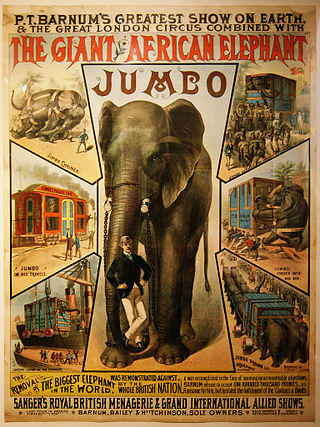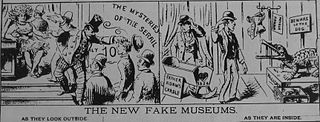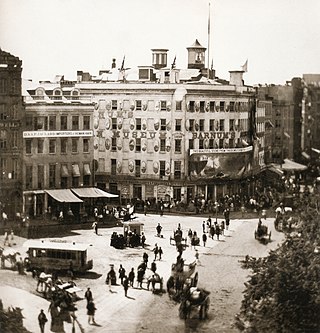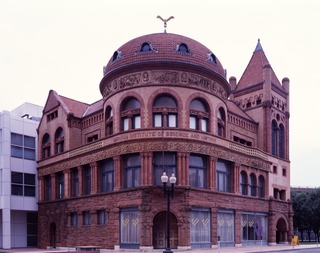
Scudder's American Museum was a museum located in New York City from 1810 to 1841, when it was purchased by P.T. Barnum and transformed into the very successful Barnum's American Museum.

Scudder's American Museum was a museum located in New York City from 1810 to 1841, when it was purchased by P.T. Barnum and transformed into the very successful Barnum's American Museum.
The roots of the museum date back to 1791, when the "American Museum" was founded by John Pintard "under the patronage of the Tammany Society." [1] It was located at 57 King Street, with Pintard serving as secretary and Gardner Baker (more of a showman between the two) as keeper. [2] The museum was moved to a building at the intersection of Pearl and Broad streets by 1794 called the "Exchange". [1] It occupied a thirty-by-sixty foot room with a high ceiling, and later opened a second room including a menagerie. [3]
It was called "Baker's American Museum" after Baker took control of it from the Tammany Society in 1795. Relying now only on ticket sales to finance operations, he raised admission prices and kept attempting to add new curiosities to draw visitors. [2] [3] After Baker died in 1798, and his widow died in 1800, the collection was purchased by William I. Waldron. [3] It then came into the hands of painter Edward Savage, who opened the "Columbian Gallery of Painting and City Museum" in 1802, and hired John Scudder to oversee the museum collection. [3]

After earning money as a seaman, the collection became the property of John Scudder in 1809, and he opened "Scudder's American Museum" in March 1810 at 21 Chatham Street. The museum moved into part of the City's former poor house in 1817, along with other civic institutions. [4] [5] Poet Fitz-Greene Halleck referenced this social experiment in an 1819 satirical piece which includes the lines: "Once the old alms house, now a school of wisdom, Sacred to Scudder's shells and Dr. Griscom."
After Scudder died in August 1821, control of the museum fell to his heirs. [6] Scudder's son (John Jr.) eventually became manager of the museum, and moved it into a five-story building on the corner of Broadway and Ann Street (across the street from St. Paul's Chapel) in December 1830. John Jr. was fired after family squabbles in 1831, and later brought back, but the family decided to sell the concern in 1841. [7]
The early collection from the Tammany years included an American bison, an 18-foot yellow snake of South American origin, a lamb with two-heads, wax figures, pieces of Indian, African, and Chinese origin. Baker also added a guillotine with beheaded wax figure. [8]
In 1823, John Scudder, Jr. authored A Companion to The American Museum as a guide to its collection. [7] By this stage (when the museum was located in the old poor house), the museum also had a forest scene in its large showroom with 80 stuffed animals and over 160 glass cases, with 600 specimens. [8]
Alexis de Tocqueville and Gustave de Beaumont visited the museum in 1831. Expecting to see paintings, Beaumont wrote that instead they "laughed like the blessed" to see the sideshow-like contents such as a "magic lantern and some stuffed birds." The museum was at that time in the five-story building that was its final home, and had four halls. The first contained the stuffed birds, the second quadrupeds and fish, the third "miscellaneous curiosities", and the last was a "Grand Cosmorama, which contains Views of most of the principal cities of the world." [9]
Holdings at the museum included the first American flag hoisted over New York City on the day the British departed in November 1783. [10]

Phineas Taylor Barnum was an American showman, businessman, and politician, remembered for promoting celebrated hoaxes and founding the Barnum & Bailey Circus (1871–2017) with James Anthony Bailey. He was also an author, publisher, and philanthropist, though he said of himself: "I am a showman by profession ... and all the gilding shall make nothing else of me." According to his critics, his personal aim was "to put money in his own coffers". He is widely credited with coining the adage "There's a sucker born every minute", although no evidence has been collected of him saying this.

Tammany Hall, also known as the Society of St. Tammany, the Sons of St. Tammany, or the Columbian Order, was a New York City political organization founded in 1786 and incorporated on May 12, 1789, as the Tammany Society. It became the main local political machine of the Democratic Party, and played a major role in controlling New York City and New York State politics and helping immigrants, most notably the Irish, rise in American politics from the 1790s to the 1960s. It typically controlled Democratic Party nominations and political patronage in Manhattan after the mayoral victory of Fernando Wood in 1854, and used its patronage resources to build a loyal, well-rewarded core of district and precinct leaders; after 1850 the vast majority were Irish Catholics due to mass immigration from Ireland during and after the Irish Famine.

Jumbo, also known as Jumbo the Elephant and Jumbo the Circus Elephant, was a 19th-century male African bush elephant born in Sudan. Jumbo was exported to Jardin des Plantes, a zoo in Paris, and then transferred in 1865 to London Zoo in England. Despite public protest, Jumbo was sold to P. T. Barnum, who took him to the United States for exhibition in March 1882.

The New-York Historical Society is an American history museum and library in New York City, along Central Park West between 76th and 77th Streets, on the Upper West Side of Manhattan. The society was founded in 1804 as New York's first museum. It presents exhibitions, public programs, and research that explore the history of New York and the nation.

Cabinets of curiosities, also known as cabinets of wonder and wonder-rooms, were collections of notable objects. Although more rudimentary collections had preceded them, the classic cabinets of curiosities emerged in the sixteenth century. The term cabinet originally described a room rather than a piece of furniture. Modern terminology would categorize the objects included as belonging to natural history, geology, ethnography, archaeology, religious or historical relics, works of art, and antiquities. In addition to the most famous and best documented cabinets of rulers and aristocrats, members of the merchant class and early practitioners of science in Europe formed collections that were precursors to museums.

Dime museums were institutions that were popular at the end of the 19th century in the United States. Designed as centers for entertainment and moral education for the working class (lowbrow), the museums were distinctly different from upper middle class cultural events (highbrow). In urban centers like New York City, where many immigrants settled, dime museums were popular and cheap entertainment. The social trend reached its peak during the Progressive Era. Although lowbrow entertainment, they were the starting places for the careers of many notable vaudeville-era entertainers, including Harry Houdini, Lew Fields, Joe Weber, and Maggie Cline.

Moses Kimball was a US politician and showman. Kimball was a close associate of P. T. Barnum, and public-spirited citizen of Boston, Massachusetts.

Evacuation Day on November 25 marks the day in 1783 when the British Army departed from New York City on Manhattan Island, after the end of the American Revolutionary War. In their wake, General George Washington triumphantly led the Continental Army from his headquarters north of the city across the Harlem River, and south through Manhattan to the Battery at its southern tip.

John Pintard, Jr. was an American merchant and philanthropist.

Andrew Haswell Green was a lawyer, New York City planner, and civic leader. He is considered "the Father of Greater New York," and is responsible for Central Park, the New York Public Library, the Bronx Zoo, the American Museum of Natural History, and the Metropolitan Museum of Art. He also participated in or led significant projects, such as Riverside Drive, Morningside Park, Fort Washington Park, and protecting the Hudson River Palisades from destruction. His last project was the consolidation of the "Imperial City" or City of Greater New York; he chaired the 1897 committee that drew up the plan of amalgamation.
Ann Street is a 3-block-long street located in the Financial District in Lower Manhattan. It runs roughly east to west from Broadway to Gold Street.

City Hall Park is a public park surrounding New York City Hall in the Civic Center of Manhattan. It was the town commons of the nascent city of New York.

Barnum's American Museum was located at the corner of Broadway, Park Row, and Ann Street in what is now the Financial District of Manhattan, New York City, from 1841 to 1865. The museum was owned by famous showman P. T. Barnum, who purchased Scudder's American Museum in 1841. The museum offered both strange and educational attractions and performances. Some were extremely reputable and historically or scientifically valuable, while others were less so.

The Barnum Museum is a museum at 820 Main Street in Bridgeport, Connecticut, United States. It has an extensive collection related to P. T. Barnum and the history of Bridgeport, and is housed in a historic building on the National Register of Historic Places.
Captain Isaiah Rynders was an American businessman, sportsman, underworld figure and political organizer for Tammany Hall. Founder of the Empire Club, a powerful political organization in New York during the mid-19th century, his "sluggers" committed voter intimidation and election fraud on behalf of Tammany Hall throughout the 1840s and 1850s before Tammany became an exclusively Irish-dominated institution.

The Boston Museum (1841–1903), also called the Boston Museum and Gallery of Fine Arts, was a theatre, wax museum, natural history museum, zoo, and art museum in 19th-century Boston, Massachusetts. Moses Kimball established the enterprise in 1841.
Taxidermy, or the process of preserving animal skin together with its feathers, fur, or scales, is an art whose existence has been short compared to forms such as painting, sculpture, and music. The word derives from two Greek words: taxis, meaning order, preparation, and arrangement and derma, meaning skin. Directly translated, taxidermy means "skin art."
The Boston Aquarial and Zoological Gardens in Boston, Massachusetts, featured a public aquarium and zoo. It was located in the Financial District on Central Court. On display were "hundreds of specimens of the finny tribe there to be seen sporting in their native element, in all their variety of hue and shape" as well as other animals. James Ambrose Cutting and Henry D. Butler ran the business, derived from an earlier incarnation known as the Boston Aquarial Gardens.P.T. Barnum bought it in 1862, renovated it, and reopened it as Barnum's Aquarial Gardens.

Madame Tussauds New York is a tourist attraction located on 42nd Street in the Times Square neighborhood of Midtown Manhattan in New York City. Madame Tussauds was founded by the wax sculptor, Marie Tussaud, and is now operated by the United Kingdom-based entertainment company, Merlin Entertainments. The Madame Tussauds New York location opened on November 15, 2000.

44 Union Square, also known as 100 East 17th Street and the Tammany Hall Building, is a three-story building at 44 Union Square East in Union Square, Manhattan, in New York City. It is at the southeast corner of Union Square East/Park Avenue South and East 17th Street. The neo-Georgian structure was erected in 1928–1929 and designed by architects Thompson, Holmes & Converse and Charles B. Meyers for the Tammany Society political organization, also known as Tammany Hall. It is the organization's oldest surviving headquarters building.